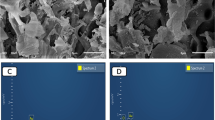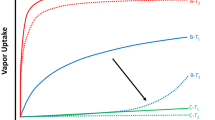Abstract
THE deactivation of highly active polar sites on activated alumina with water to give a satisfactory column packing for the gas chromatographic separation of C1–C5 hydrocarbons at room temperature has been reported1. An extension of this work has shown that alumina can be similarly deactivated with inorganic bases and salts added in aqueous solution, the water being removed by subsequent heat treatment. At low degrees of deactivation, retention volumes for aromatic hydrocarbons can be varied relative to aliphatic hydrocarbons according to the extent of deactivation. However, the amount of sample required (∼100 µgm.) to obtain a response from a flame-ionization detector suggests that considerable irreversible adsorption takes place. The most promising application appears to be at the highest degrees of deactivation (lowest activity-levels, when irreversible adsorption is much reduced) for the separation of high-molecular weight hydrocarbons.
This is a preview of subscription content, access via your institution
Access options
Subscribe to this journal
Receive 51 print issues and online access
$199.00 per year
only $3.90 per issue
Buy this article
- Purchase on Springer Link
- Instant access to full article PDF
Prices may be subject to local taxes which are calculated during checkout
Similar content being viewed by others
References
Scott, C. G., J. Inst. Pet., 45, 118 (1959).
Eglinton, G., Hamilton, R. J., Hodges, R., and Raphael, R. A., Chem. and Indust., 955 (1959).
Author information
Authors and Affiliations
Rights and permissions
About this article
Cite this article
SCOTT, C., ROWELL, D. Gas-Solid Chromatographic Separation of Hydrocarbons of High Molecular Weight. Nature 187, 143–144 (1960). https://doi.org/10.1038/187143a0
Issue Date:
DOI: https://doi.org/10.1038/187143a0
This article is cited by
-
Complete separation of ephedrines by graphite-layer open-tubular (GLOT) column
Chromatographia (1996)
-
Considérations théoriques sur l'analyse des produits peu volatils par chromatographie en phase gazeuse
Chromatographia (1971)
-
Der thermische Faktor in der Graschromatographie
Fresenius' Zeitschrift für analytische Chemie (1962)
Comments
By submitting a comment you agree to abide by our Terms and Community Guidelines. If you find something abusive or that does not comply with our terms or guidelines please flag it as inappropriate.



